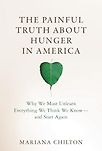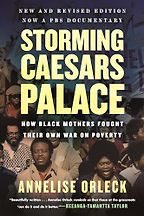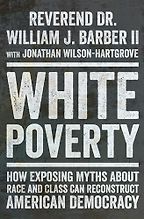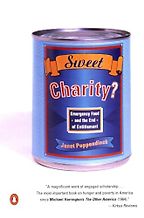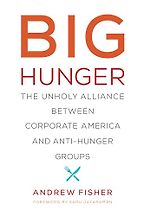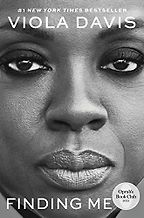Your book is called The Painful Truth about Hunger in America. What is the painful truth that people might not know?
My book is grounded in the wisdom and expertise of people who know hunger firsthand, and I’m very committed to being in solidarity with them. The book is about the last 25 years of my work, where I was interviewing and working alongside primarily Black and brown women who were trying to break out of poverty in the city of Philadelphia and beyond.
The first part of the book is about the women explaining what the experience of hunger is like. Underneath the experience of hunger, from their point of view, is an experience of terrible violence and neglect and disrespect.
For instance, I would approach them to talk about having enough money for groceries, or how they feed their kids and the quality of the food. Almost immediately they would bring me to what’s going on underneath hunger, which is major stress and deprivation and depression and anxiety. When I asked about the depression and anxiety, they would say, ‘Well, when I was a kid, I was raped, and I’ve been very depressed. I couldn’t focus in school. I dropped out, I couldn’t get a job’—those kinds of things. So the painful truth is really about the violence underneath hunger. That forced me to not only look in the mirror, and how I am potentially complicit in this dynamic, but also ask, ‘How is it that our society allows this kind of violence and hunger to continue?’
The second part of the book talks about the programs that we have in place in the United States to address hunger. That’s food stamps and school breakfast and school lunch. And I expose the violence in those systems as well. That allows me to step back and look at the violence in our society and how we tolerate it. It goes all the way back to the Papal Bulls, to colonization, to genocide, to enslavement. I talk about that deep, painful truth that is also about our society.
In the third part of the book, I talk about how — knowing that underneath hunger is so much trauma and pain and disrespect — do we bring more love into our society, into ourselves and into our world and into our spirits? How can you bring love into public policy? The primary policy approaches I talk about are reparations for descendants of people who were enslaved and giving land back to Indigenous people. Those are the two most important things to be done, because those are two major wounds that we have that are still reverberating in our history.
Then I talk about the types of programs that can be put into place that promote solidarity and more equanimity in our society. That would include universal health care. We have a terrible healthcare system in the United States, where people have to pay or they have to be working in order to get healthcare. This is unconscionable. I also talk about universal basic income, so that everyone has the same baseline for meeting their basic needs.
But hunger is an issue across ethnic groups isn’t it?
Very much so. In terms of sheer numbers, more white people than Black and Indigenous people experience hunger in the United States. That’s really important to remember, and that’s why I’m recommending the book White Poverty.
But if you look at the burden on the population that identifies or is identified as Black, you can see that Black families have three to four times the rate of hunger when they’re compared to the rates of hunger in white families. That’s where the real story starts to unfold. You look at where the highest rates of hunger are, and you see that the peoples who have the highest rates of hunger are those who are most discriminated against: Black people, Indigenous people, women, immigrants, people with disabilities, people who are queer.
How many people go hungry in the US? What’s the scale of the problem in terms of the statistics?
13.5% of the households in the United States have reported food insecurity in 2023. That constitutes about 30 million individuals. About one in five children experiences household food insecurity, and 50% of the newborns in the United States are born into poverty.
Indigenous people in the United States have rates of hunger that are between 25% to 90% of their population, depending on which nations. Women-headed households have rates of food insecurity that are about 30%. Again, think about how that compares to the national rate of 13.5% and that helps you to see the major inequities in the rates of food insecurity.
I wonder how that compares to the rates here in Europe.
I know that for all of the supposedly highly developed countries, the United States has the highest rates. But again, it’s not just about looking at the national levels. You’ve got to look underneath to find out what’s really going on. And the fact that you can have some tribes and nations that have rates of hunger at 80% to 90% of the population is deeply concerning.
Let’s go through the books you’ve chosen. First up is Storming Caesar’s Palace: How Black Mothers Fought Their Own War on Poverty, which is by Annelise Orleck, a historian.
I love this book because it talks about a fabulous advocate named Ruby Duncan and the people that she was working to organize. Annelise Orleck interviewed a lot of the women who were part of the Welfare Rights Movement in Las Vegas, Nevada in the late 1960s and early 1970s. What makes the book so exciting is that she gets into their stories about coming up from the South and coming to Las Vegas to try to get better jobs. They explained how their kids were so poor and hungry that they became absolutely desperate and angry at the same time. Many of them had applied for public assistance or welfare. That was barely keeping them alive, and they were struggling.
It starts out with the public assistance administrators cutting people off the rolls without any warning. All of a sudden, people were cut off of welfare and their families became hungrier and hungrier. The women got so angry, they organized themselves. They did a lot of protests, they wrote letters and they advocated for themselves. That, for me, is a really important experience of understanding hunger in America. People are not just victims of hunger. They can take action.
I was very inspired by these stories. They demonstrate that hunger never happens in a vacuum. When hunger is happening to people, there are many other things going on around it. The book teaches us that the systems that are in place can be really helpful or they can be very harmful, and they can be weaponized.
So the casino owners were collaborating with the welfare administrators to keep welfare benefits very low so that people would be willing to work for low wages. It shows us that big businesses in the United States do everything they possibly can to keep wages low. There was the idea that if welfare benefits were too high, people were not going to go work for wages that were less. The women found out about that, and they went and protested against the wages at the casinos. That’s really exciting, because those are some very powerful institutions.
So this book was really important to me for understanding that women can take action. When they get together, they can have a lot of power. It also shows us how integral all of these different systems are in terms of generating hunger or treating hunger.
The other thing I like about Ruby Duncan and her work is that she was able to start a clinic for families and give out WIC benefits. The WIC Program is a really important program. It stands for Women, Infants and Children, and it’s only in the United States. It’s a special nutrition program for pregnant and lactating mothers and young children under the age of five. It helps children to develop better and prevents preterm births. So Ruby Duncan brought that to her clinic in Southern Nevada. I like it that women were taking control of the situation in their own communities.
It’s an important piece of history that a lot of people don’t remember or don’t know about. It inspired me to develop a program called Witnesses to Hunger, where I worked with low-income women. I gave each of them a camera to talk about their experiences, and then we created exhibits so that they can use their photographs to educate the public, the press and policymakers and have an influence on the public policies that are having an impact on them. It was quite successful. We had several women testify before Congress and we think that the members of Witnesses to Hunger were instrumental in increasing the SNAP benefits (SNAP is food stamps, it’s a program where people can get money to buy groceries in the United States).
So, for me, this book is really important. Annelise Orleck is a fantastic historian, because she includes oral history. She talks directly to people. She understands social movements.
She also lives the social movements in her own life. Last spring in the United States, there were a lot of students on campuses around the country protesting against genocide in Gaza. She was near her students when the police were attacking them, even though the students were being very peaceful and were not breaking the law. She got in between them and said, ‘These are my students. They’re not doing anything wrong. Please don’t harm them.’ And the police threw her to the ground. That’s actually on video. What’s so shocking is that you have this very esteemed historian and professor who’s just talking about peace and understanding and trying to protect people’s lives, and she gets brutalized. Unfortunately, I think that’s a mirror into who we are in the United States. It’s deeply concerning.
But I just love Annelise Orleck, I look up to her, and I’m grateful for that book. There’s a movie that people can look at on PBS that is also called Storming Caesar’s Palace. It interviews Ruby Duncan, 30 or 40 years later.
Let’s move to the next book on your list. White Poverty: How Exposing Myths about Race and Class Can Reconstruct American Democracy is by William J. Barber, who’s a pastor, I think, rather than an academic?
He is. Reverend Barber is an amazing person who carries on Martin Luther King’s vision. In the late 1960s, before Martin Luther King was murdered, he was getting poor people around the country, of all different colors, to come together to advocate for anti-poverty programs. Reverend Barber has carried that forward. He’s been running the Poor People’s Campaign for a couple of decades now. He goes around the country to interview people and get them organized, to talk about the experience of poverty, to make sure that it’s on the national stage and in the national conversation.
What I like about White Poverty is that he talks about the experience of racism in the United States and goes all the way back to enslavement and the first slave ships that arrived. He explains how landowners started to create the myth that skin color has something to do with whether you’re worth being paid or not. He demonstrates that a lot of poor white people were convinced, also via legislation, that they were different than the Black folks who had to work for free who were enslaved.
“Hunger can never be understood in a vacuum”
White people did not want to be associating with Black people because there were laws against it. Both during enslavement and after emancipation, there were laws that restricted white people from going into business or even congregating with Black people. Certainly, they should not be having intimate relationships.
He shows the deep damage of that myth — that white people are not poor, or that white people’s poverty is different than Black people’s poverty. It’s the same type of poverty. It’s the same experience. But a lot of white people get convinced that the policies and programs that harm them are not harmful because they think it only pertains to Black people.
So it’s a really beautiful investigation of the racism that’s embedded in the United States and how people buy into these terrible myths that white people are not poor, or that white people and Black people can’t organize together. By talking about the Poor People’s Campaign, he shows how people of all different backgrounds can come together to talk about the same issues, the same struggles, and through their social action improve our democracy in the United States.
What I also love about Reverend Barber is that he’s very prophetic. He knows his scripture, and it’s really beautiful to read his work. It reminds us that we are all aspiring to be happy. We are all aspiring to be in a good relationship with each other. I just love the way he uses his scripture.
I highly recommend that book. It’s a very inspiring book, and it reminds everyone that more white people than Black people are suffering in America in terms of sheer numbers.
What are the practical implications of this ignorance around poverty?
For example, in the United States, we have a program called Medicaid. It’s healthcare for people who are poor, who are not working, or who are disabled or who can’t afford to pay for their healthcare. During the Obama administration, there was Medicaid expansion. There were lots of states that were able to expand the number of people that they could support through Medicaid to get healthcare. But the states that had higher rates of Black people who were poor, primarily in the South, refused to expand Medicaid because they thought more Black people would benefit from it. What happens is that the legislators — and the white people that they represent — think that any kind of social program that is put into place is not helping white people, but only helping Black people.
So that’s why in this book Reverend Barber talks about breaking down these myths: the myth that white people don’t get help with these public assistance programs. They’re the primary ones who do get the help.
There’s also a sense of fear towards Black people that a lot of white people have. All of this fearmongering that has happened since the time of colonization, of enslavement, has stayed with us up to today. I don’t know if you know anything about American politics right now, but it is unbelievable, the type of racism that is allowed to be spewed in the public domain. A lot of white people who are poor get really concerned and think, ‘They’re getting more than me, and that’s not fair.’ In the meantime, they’re in the same boat. They just can’t see that they’re in the same boat.
Let’s go on to Sweet Charity? Emergency Food and the End of Entitlement which is by sociologist Jan Poppendieck.
I love Sweet Charity?. This was another book that had a major influence on me early in my career. It was published in 1998 but it’s still very relevant today.
What Sweet Charity? demonstrates is that when you have food pantries and food banks growing in number, it is a direct indication of the loss of democracy, of public programs, and the cutting away of public assistance programs. So back in the 70s, after the time of the Welfare Rights Movement and Jimmy Carter, you had a lot of fantastic programs that were coming up and hunger was going way down. It was phenomenal. But then Ronald Reagan came into power and started cutting all of these assistance programs: the food stamp program, the WIC program, housing assistance. Wages started getting very stagnant, and so in order to make up for the loss of investment by government, churches and community organizations started running food pantries.
So there’s a direct correlation between what the government stopped doing for its people and what different churches started to do. Ronald Reagan and many others encouraged the idea that all of a sudden basic needs should be met with charity.
So what Jan Poppendieck does in this book is she problematizes charity. She talks about how in all religions, we don’t like people to go hungry. All religions talk about feeding and clothing the poor. This is a deep spiritual need that we have, to ensure that no one goes hungry. But she talks about how that gets utilized by the emergency food system. The people who are working in the emergency food system — food banks, food pantries, food cupboards — feel as if they’re doing spiritual work, but what they’re doing is encouraging more of a breakdown in democracy. The quality of the food is very poor. It’s not always accessible. It’s a scattershot system.
What I like is that she’s interviewed people who work in the system to show the good intentions, but that those good intentions actually can cause harm.
That book is important for people to read, because she talks about how easy it is for us to let ourselves off the hook by saying, ‘I give cans of food to the poor, so I’m helping to address hunger.’ Actually, you’re not. I have a chapter on that in my own book called “Feeding America with Pounds of Food”. I talk about how the emergency food system simply lifts up people who are wealthy and praises them for giving money to the food banks. And anybody who goes to a food bank is humiliated and is squashed down. It feeds into what I talk about as a culture of domination. That charity model is a culture of domination in and of itself.
Food is a fundamental human right and we have to start thinking about it like that. Most of the world does think that way, except for in the United States and perhaps the UK. The growth of Trussell Trust is deeply concerning. People think, ‘Oh, thank god Trussell Trust is there to make sure that food is getting to folks.’ But they have simply taken the emergency food system model in the United States and taken it to the UK. I’m here to tell you it doesn’t work. It’s very scattershot. The quality of the food is poor, and the people who benefit the most are the food industry and the food companies, which brings me to the next book.
But what do you do? Do you stop donating to food banks? That doesn’t seem like a good solution either.
It could potentially be a solution. But when you’re donating it’s not clear you’re really helping.
Let’s talk about Walmart in the United States. This is where you learn about the dynamics of the big business that’s involved in emergency food. Walmart doesn’t want to pay the huge dump fees when food is outdated or going bad. They have to pay a fee, and they have to pay the trucker to get the food to the dump. So in order to avoid those fees, they donate the food to Feeding America, the big food bank conglomerate. Feeding America comes to pick up the food. Not only does Walmart not have to pay for the dumping, but they get a huge tax write-off because they donated it. So that keeps Walmart’s profits very high. Then they get goodwill, because everybody thinks, ‘Oh, Walmart really cares about the poor’ — because we all believe the stupid myth that helping hungry people has to do with food, and that the big businesses can save us.
This is not true. Walmart pays wages that are so low that a person cannot afford to buy food with them. So they get public assistance — SNAP benefits or food stamps — from the US government to supplement those wages. They also get Medicaid, which is healthcare. The government is supplementing the wages that Walmart refuses to pay. Then, finally, the people who work at Walmart use their food stamps at Walmart. Walmart is getting so much money back from donating food to Feeding America.
Hunger has become big business in the United States and that’s where Big Hunger comes in.
Yes, let’s talk about Big Hunger: The Unholy Alliance between Corporate America and Anti–Hunger Groups by Andrew Fisher.
Everybody who works in the emergency food system understands that if you’re going to address food insecurity, you need to pay higher wages, give better benefits for people who are disabled, and support families, because the vast majority of people who are on public assistance are either disabled or have young children. They want to advocate on increasing wages, but they can’t do it because the big companies that hold up the emergency food system are the same companies that want to keep wages low. Which brings us all the way back to Caesar’s Palace — to show you how much everybody is collaborating to keep the poor poor and build everybody else’s profits.
In Big Hunger Andy Fisher shows that. He updates Jan Poppendieck’s work and shows that the big food companies squash any attempt for advocacy on increasing wages. He demonstrates that those big companies are the ones paying the CEOs of the food banks high salaries so the people who run the food banks don’t advocate on hunger. They’re just pushing food around. They’re not really working to address hunger, nor have they even read books about hunger, which is why this is a really good thing that you’re doing to get people to read more about it.
He builds on Poppendieck’s argument that this is really about the loss of democracy. Andy Fisher shows how big business is in control of what’s going on in the United States when it comes to our society and how we allow poverty to continue. Hunger is big business.
Going back to your question — should people donate to food banks? They should think twice. Maybe just help your neighbor and give them cash, or make sure that the government has the appropriate social assistance programs. The concept of a welfare state, without the stigma, is that you help people meet their basic needs, and that it should be the government doing that. That’s what taxes are for.
We chose books about hunger in the United States as the theme for this interview, but what’s the difference between hunger and poverty?
Hunger can never be understood in a vacuum. Hunger never happens by itself. You have to be poor to experience hunger, unless you’re fasting or something. And if you’re poor, that means you can’t pay your rent, maybe you don’t have a job, or you’re very isolated, or you are extremely depressed because you’ve experienced a lot of abuse or racism. All of those things are tied up with hunger. Oftentimes you hear me or others talk about poverty and hunger almost as one and the same. Hunger captures people’s attention because we all experience hunger on a day-to-day basis. We need to eat. So we have a sense of what that could be like, and we all have a spiritual understanding that no other person should go hungry. That’s just built into what it means to be an animal, what it means to be alive. We don’t want our people to be hungry. So hunger becomes an easy way to talk about poverty.
Hunger is the thing in public health that becomes something measurable that we can understand and helps us get a sense of what the experience of poverty is like.
Don’t try to disentangle hunger from poverty. You can be poor and not be hungry. But that thinking can also become a trap. Poverty without hunger is like being in a gilded cage or in prison. I can take this even further: sometimes people will go to prison so that they have a place to sleep and some food to eat. So they’re not technically ‘hungry,’ but they’re trapped.The quality of the food is pretty bad, and conditions are bad too.
And hunger won’t be solved just by giving people more food?
That helps them maybe for two or three days, but it’s not going to help them get up and out of poverty. It may help them to be slightly healthier. It might help them stay out of the hospital, but they’re still going to be poor. It’s like a cycle that continues and continues and continues.
Lastly, you’ve recommended a memoir, Finding Me by Viola Davis.
Viola Davis is one of the greatest actors of our times. She’s the detective in the series How to Get Away with Murder and she’s been in many movies. In her memoir, she talks about the experience of being hungry growing up. She talks about her childhood from the perspective of a Black woman in America, in Rhode Island. You think, ‘Oh, that’s in the northeast, nobody is really struggling there.’ And she shows you, through her own memories, what was really happening with her family.
As a Black family in Providence, her parents had a hard time finding jobs. They were so poor they had no new clothes. There was abuse in the family, and abuse in the neighborhood. She talks about getting bullied at school, how her teachers mistreated her because she was Black and also poor. She didn’t smell good because she wet her bed. Her parents couldn’t help with that either, because they were so stressed. What she demonstrates is the deep stress of poverty, and how that stress creates more opportunities for abuse and for discrimination.
It’s a harrowing read, but it’s also really inspiring because she talks about how hard she worked to figure out how to get out of it. She was the only one of her siblings who was able to get up and out. She’s really one in a million. This is not an example of how people should do it. She’s in the stratosphere in terms of being able to get out of poverty and be so talented as an actor.
But what I like about this memoir is that it’s a very unapologetic opening into the life of someone who is very poor and experienced hunger. She has a great quote in one of her chapters (which I use in my book as well) about how “the invisibility of the one-two punch that is Blackness and poverty is brutal. Mix that with being hungry all the damn time and it becomes combustible.” My book is academic. I talk about the history of enslavement and colonization and genocide, and I talk about rape, and about undoing rape culture. I have a lot of analysis and a lot of ideas about what to do about it.
What I like about Viola Davis’s book is she opens up a window for you to experience what it’s like through her eyes. I was riveted. It’s a fantastic read. I could not put that book down. It confirmed all that I had learned from the women that I spoke to in Philadelphia. A lot of people were wary of my analysis of the violence underneath hunger, and didn’t want me to talk about it. They said, ‘Mariana, let’s just get more food stamps for everybody and everything will be fine. More food, food, food.’ I was insisting, ‘No, this is deeper. Especially the women’s experiences were so filled with violence and so much racism and gender discrimination.’ When I read Viola Davis’s book, I thought, ‘Okay, I feel confident now in releasing this book.’ She’s just one person, but just reading her story made me realize I’ve got to get the stories of the women that I talked to out there, and that we really have to change. We cannot allow this kind of hunger and poverty to persist in the United States.
People love Viola Davis — obviously I do too. If people could read this memoir, they would have a sense of camaraderie with her, of solidarity and love that maybe will expand their hearts so that they can start to take action in the United States to change things.
October 27, 2024. Updated: November 2, 2024
Five Books aims to keep its book recommendations and interviews up to date. If you are the interviewee and would like to update your choice of books (or even just what you say about them) please email us at [email protected]
Five Books interviews are expensive to produce. If you've enjoyed this interview, please support us by donating a small amount.

